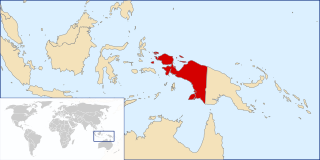| Wiru River | |
|---|---|
| Location | |
| Country | |
| Region | Papua |
| Physical characteristics | |
| Source | |
| • location | Indonesia |
| Mouth | |
• coordinates | 5°42′07″S139°18′58″E / 5.70204°S 139.31603°E |
The Wiru River is a river in Western New Guinea. [1]
| Wiru River | |
|---|---|
| Location | |
| Country | |
| Region | Papua |
| Physical characteristics | |
| Source | |
| • location | Indonesia |
| Mouth | |
• coordinates | 5°42′07″S139°18′58″E / 5.70204°S 139.31603°E |
The Wiru River is a river in Western New Guinea. [1]
Indo-Pacific is a hypothetical language macrofamily proposed in 1971 by Joseph Greenberg and now believed to be spurious. It grouped together the Papuan languages of New Guinea and Melanesia with the languages of the Andaman Islands and, tentatively, the languages of Tasmania, both of which are remote from New Guinea. The valid cognates Greenberg found turned out to be reflexes of the less extensive Trans–New Guinea family. Recently the Kusunda language, which is generally seen as a language isolate, is also included in the Indo-Pacific proposal. Greenberg did not include "Australian" in his original 1971 proposal.

The indigenous peoples of Western New Guinea in Indonesia and Papua New Guinea, commonly called Papuans, are Melanesians. There is genetic evidence for two major historical lineages in New Guinea and neighboring islands: a first wave from the Malay Archipelago perhaps 50,000 years ago when New Guinea and Australia were a single landmass called Sahul and, much later, a wave of Austronesian people from the north who introduced Austronesian languages and pigs about 3,500 years ago. They also left a small but significant genetic trace in many coastal Papuan peoples.


Western Province is a coastal province in southwestern Papua New Guinea, bordering the Indonesian provinces of Highland Papua and South Papua. The provincial capital is Daru. The largest town in the province is Tabubil. Other major settlements are Kiunga, Ningerum, Olsobip and Balimo.

Southern Highlands is a province in Papua New Guinea. Its provincial capital is the town of Mendi. According to Papua New Guinea's national 2011 census, the total population of Southern Highlands is 515,511 spread across 15,089 square kilometers (5,826 sq mi).

Lauricocha Province is one of 11 provinces of the Huánuco Region in Peru. The capital of the province is Jesús. The province is found at high elevations in the Andes. The highest elevation in the province is snow-capped Yerupaja peak with an elevation of 6,617 m (21,709 ft) and the lowest elevation is approximately 3,200 m (10,500 ft) along the Marañon River north of the town of Rondos. The population of the province was 19,956 in 2017 and had been declining for many years before that.
East New Guinea Highlands is a 1960 proposal by Stephen Wurm for a family of Papuan languages spoken in Papua New Guinea that formed part of his 1975 expansion of Trans–New Guinea.

Papua New Guinea, a sovereign state in Oceania, is the most linguistically diverse country in the world. According to Ethnologue, there are 840 living languages spoken in the country. In 2006, Papua New Guinea Prime Minister Sir Michael Somare stated that "Papua New Guinea has 832 living languages ." Languages with statutory recognition are Tok Pisin, English, Hiri Motu, and Papua New Guinean Sign Language. Tok Pisin, an English-based creole, is the most widely spoken, serving as the country's lingua franca. Papua New Guinean Sign Language became the fourth officially recognised language in May 2015, and is used by the deaf population throughout the country.

The Turama–Kikorian languages are a family identified by Arthur Capell (1962) and part of the Trans–New Guinea languages (TNG) family in the classifications of Stephen Wurm (1975) and Malcolm Ross (2005). The family is named after the Turama River and Kikori River of southern Papua New Guinea; the alternative name is based more narrowly on the Omati River.

The Engan, or more precisely Enga – Southern Highland, languages are a small family of Papuan languages of the highlands of Papua New Guinea. The two branches of the family are rather distantly related, but were connected by Franklin and Voorhoeve (1973).

New Guinea is the world's second-largest island, with an area of 785,753 km2 (303,381 sq mi). Located in Melanesia in the southwestern Pacific Ocean, the island is separated from Australia by the 150-kilometre wide Torres Strait, though both landmasses lie on the same continental shelf. Numerous smaller islands are located to the west and east.
The Wiru are a people of the Southern Highlands Province of Papua New Guinea. They speak the Wiru language. Among their rituals is the production of timbuwarra out of rattan.

Wiru or Witu is the language spoken by the Wiru people of Ialibu-Pangia District of the Southern Highlands Province of Papua New Guinea. The language has been described by Harland Kerr, a missionary who lived in the Wiru community for many years. Kerr's work with the community produced a Wiru Bible translation and several unpublished dictionary manuscripts, as well as Kerr's Master's thesis on the structure of Wiru verbs.
Wiru or Witu may refer to:

The Papuan Gulf languages are a proposed language family of Papuan languages spoken inland from the large gulf that defines the shape of southern Papua New Guinea.
The Teberan–Pawaian languages, or Tua River languages, are a family of Papuan languages, established by Timothy Usher, that are spoken in the region of the Tua River. They are the Teberan languages and the Wiru and Pawaia isolates. Teberan and Pawaian had previously been linked, along with the East Kutubuan languages, in Wurm's 1975 Trans-Murray branch of Trans–New Guinea.
Proto-Trans–New Guinea is the reconstructed proto-language ancestral to the Trans–New Guinea languages. Reconstructions have been proposed by Malcolm Ross and Andrew Pawley.
Wiru Rural LLG is a local-level government (LLG) of Southern Highlands Province, Papua New Guinea. The Wiru language is spoken in the LLG.